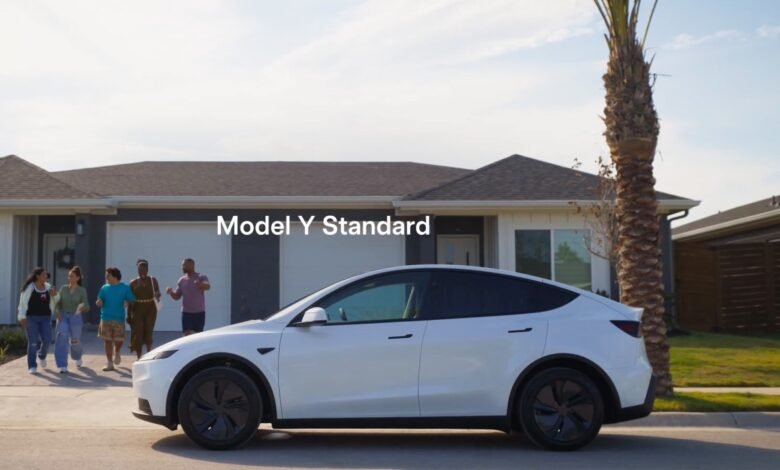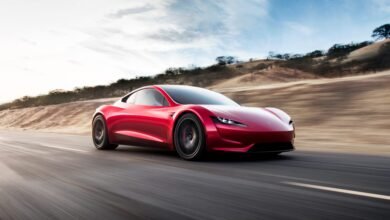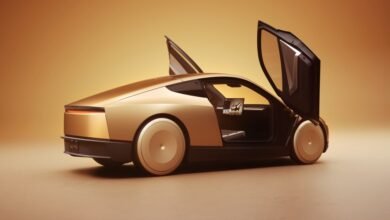Tesla Debuts More Affordable Model 3 and Model Y

▼ Summary
– Tesla has launched more affordable “Standard” versions of its Model 3 and Model Y, priced at $36,990 and $39,990 respectively.
– These new models have a 321-mile range and lack features like Autopilot, with manual adjustments and fewer interior amenities such as no second-row touchscreen or FM/AM radio.
– The release aims to boost Tesla’s growth after a 2024 sales decline, though the prices are higher than the previously teased $25,000 model that was canceled.
– The vehicles feature significant cost-cutting measures, including the removal of the light bar and glass roof, reflecting Tesla’s strategy to reduce production expenses.
– Tesla plans to sell these models globally, facing a competitive EV market with other automakers like Ford and GM introducing low-cost options, while the end of the U.S. federal EV tax credit affects pricing.
After more than a year of anticipation, Tesla has officially launched its more affordable Model 3 and Model Y variants, with starting prices set at $36,990 for the Model 3 sedan and $39,990 for the Model Y SUV. These new “Standard” versions are designed to provide a lower entry point into the Tesla ecosystem, though they arrive with a noticeably pared-down set of features compared to their premium counterparts.
Each Standard model is estimated to deliver up to 321 miles of range on a full battery charge. However, buyers will find several key omissions. The basic Autopilot advanced driver assistance system is not included; instead, the cars come equipped only with traffic-aware cruise control, lacking the Autosteer function that completes the Autopilot package. These models are expected to begin shipping later this year.
The introduction of these lower-cost vehicles is a strategic move intended to reignite Tesla’s sales growth following a decline in 2024. Despite this, the pricing has not met the expectations of some industry observers, particularly in light of CEO Elon Musk’s past hints about a potential $25,000 Tesla, a project that was ultimately shelved. Notably, the new Model 3’s price does not fall below the $35,000 benchmark that Tesla famously promoted ahead of the car’s original 2016 debut, a price point that was only briefly available as a special order.
Inside, the differences are more pronounced than the exterior suggests. The Standard versions embrace an extremely minimalist, or spartan, design philosophy. They do not include a second-row touchscreen, and adjustments for the steering wheel and side mirrors must be done manually. The audio system is simplified, offering just seven speakers and lacking FM/AM radio, a significant step down from the 15-speaker setup with a subwoofer found in higher trims. Heated seats are available only for the front row.
Externally, the Standard Model Y loses the distinctive front light bar seen on more expensive variants, and both the Model 3 and Model Y Standard models do not feature a glass roof.
This cost-cutting approach reflects a long-standing company strategy. Musk and other Tesla executives have frequently referred to an intense, detailed effort to remove expenses, a process they’ve humorously described as playing “Game of Thrones but for pennies.” This philosophy of stripping vehicles down to their essentials appears to be the core tactic behind the development of the Standard models.
Tesla plans to sell these versions in numerous global markets, including Europe. In the United States, the recent expiration of the federal EV tax credit means the advertised prices are the final cost for most buyers, barring any applicable state-level incentives.
This pricing strategy creates a new dynamic for potential EV customers. The landscape is shifting as several major automakers scale back plans for high-end electric vehicles, potentially reducing competition in the more affordable segment. This could work to Tesla’s advantage.
Meanwhile, other players are preparing their own entries. Ford is developing a new low-cost EV platform slated for a 2027 release, and General Motors is reviving the Chevy Bolt. Newer competitors like Rivian, Lucid Motors, and Slate Auto are also pushing to launch electric vehicles in the coming years, with prices expected to compete directly with Tesla’s new Standard offerings.
Earlier this year, Musk’s involvement with the second Trump administration caused tangible harm to the Tesla brand. The company subsequently rebounded to achieve its best-ever quarter, a surge partly attributed to the expiring EV tax credit. It remains uncertain how long this positive momentum will last. The new Standard models are likely to exert competitive pressure not only on Tesla’s own more expensive vehicles but also on the broader used car market.
(Source: TechCrunch)





